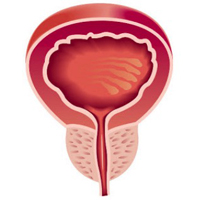Minimally invasive simple prostatectomy: Robotic-assisted versus laparoscopy. A comparative study

Accepted: February 21, 2022
All claims expressed in this article are solely those of the authors and do not necessarily represent those of their affiliated organizations, or those of the publisher, the editors and the reviewers. Any product that may be evaluated in this article or claim that may be made by its manufacturer is not guaranteed or endorsed by the publisher.
Purpose: Robotic-assisted simple prostatectomy (RASP) is a novel surgical procedure for the management of obstructive symptoms caused by enlarged prostate glands. Before the introduction of minimally invasive techniques, the standard approach was the open simple prostatectomy (OSP). The aim of our study was to compare intraoperative and perioperative outcomes of robotic (RASP) and laparoscopic (LSP) simple prostatectomy.
Methods: We retrospectively analyzed data from patients who underwent minimally invasive simple prostatectomy at the Urological Department of Portogruaro Hospital, Portogruaro, and at the Urological Department of “San Bassiano” Hospital, in Bassano del Grappa, from March 2015 to December 2020. Data collected from medical records included age, body mass index, prostate volume, operative time, preoperative International Prostatic Symptoms Score (IPSS), postoperative IPSS, time with drainage, blood transfusion, intraoperative complications, perioperative complications and length of hospital stay.
Results: Robotic-assisted (n = 25) and laparoscopic simple prostatectomy (n = 25) were performed with a transvesical approach. No significant differences were observed regarding baseline characteristics, body mass index, prostate volume and IPSS. Operative time was lower in the laparoscopic group (122 min vs 139 min) (p = 0.024), while hospital stay was lower in the robotic group (4 days vs 6 days) (p = 0.047).
Conclusions: Robotic-assisted simple prostatectomy is a safe technique with results comparable to laparoscopic simple prostatectomy, encompassing the advantage of a shorter hospitalization. Considering the costs and the limited availability of robotic-assisted simple prostatectomy, laparoscopic simple prostatectomy is a valid and safe alternative for experienced surgeons.
Lokeshwar SD, Harper BT, Webb E, et al. Epidemiology and treatment modalities for the management of benign prostatic hyperplasia. Transl Androl Urol. 2019; 8:529-39. DOI: https://doi.org/10.21037/tau.2019.10.01
Fogaing C, Alsulihem A, Campeau L, Corcos J. Is early surgical treatment for benign prostatic hyperplasia preferable to prolonged medical therapy: pros and cons. Medicina. 2021; 57:368 DOI: https://doi.org/10.3390/medicina57040368
Gul ZG, Kaplan SA. BPH: why do patients fail medical therapy? Cur Urol Rep. 2019; 20:1-7. DOI: https://doi.org/10.1007/s11934-019-0899-z
Bortnick E, Brown C, Simma-Chiang V, Kaplan SA. Modern best practice in the management of benign prostatic hyperplasia in the elderly. Ther Adv Urol. 2020; 12:1756287220929486. DOI: https://doi.org/10.1177/1756287220929486
Gratzke C, Bachmann A, Descazeaud A, et al. EAU guidelines on the assessment of non-neurogenic male lower urinary tract symptoms including benign prostatic obstruction. Eur Urol. 2015; 67:1099-109. DOI: https://doi.org/10.1016/j.eururo.2014.12.038
Elshal AM, El-Nahas AR, Barakat TS, et al. Transvesical open prostatectomy for benign prostatic hyperplasia in the era of minimally invasive surgery: Perioperative outcomes of a contemporary series. Arab J Urol. 2013; 11:362-8. DOI: https://doi.org/10.1016/j.aju.2013.06.003
Mariano MB, Graziottin TM, Tefilli MV. Laparoscopic prostatectomy with vascular control for benign prostatic hyperplasia. J Urol. 2002; 167:2528-9. DOI: https://doi.org/10.1016/S0022-5347(05)65025-2
Kordan Y, Canda AE, Köseoglu E, et al. Robotic-assisted simpleprostatectomy: a systematic review. J Clin Med. 2020; 9:1798. DOI: https://doi.org/10.3390/jcm9061798
Xia Z, Li J, Yang X, Jing H, et al. Robotic-assisted vs. open simple prostatectomy for large prostates: a meta-analysis. Front Surg. 2021;8:695318. DOI: https://doi.org/10.3389/fsurg.2021.695318
Lucca I, Shariat SF, Hofbauer SL, Klatte T. Outcomes of minimally invasive simple prostatectomy for benign prostatic hyperplasia: a systematic review and meta-analysis. World J Urol. 2015; 33:563-70. DOI: https://doi.org/10.1007/s00345-014-1324-3
Pariser JJ, Pearce SM, Patel SG, Bales GT. National trends of simple prostatectomy for benign prostatic hyperplasia with an analysis of risk factors for adverse perioperative outcomes. Urology. 2015;86:721-6. DOI: https://doi.org/10.1016/j.urology.2015.06.048
Li J, Cao D, Peng L, et al. Comparison between minimally invasive simple prostatectomy and open simple prostatectomy for large prostates: a systematic review and meta-analysis of comparative trials. J Endourol 2019;33:767-76. DOI: https://doi.org/10.1089/end.2019.0306
Esposito C, Masieri L, Castagnetti M, et al. Letter to the Editor: robot-assisted and minimally invasive pediatric surgery and urology during the COVID-19 pandemic: a short literature review. J Laparoendosc Adv Surg Tech A. 2020; 30:915-8. DOI: https://doi.org/10.1089/lap.2020.0251
Ahmed K, Ibrahim A, Wang TT, et al. Assessing the cost effectiveness of robotics in urological surgery - a systematic review. BJU International. 2012; 110:1544-56. DOI: https://doi.org/10.1111/j.1464-410X.2012.11015.x
Demir A, Günseren K, Kordan Y, et al. Open vs laparoscopic simple prostatectomy: a comparison of initial outcomes and cost. J Endourol. 2016; 30:884-9. DOI: https://doi.org/10.1089/end.2016.0261
Stolzenburg JU, Kallidonis P, Kyriazis I, et al. Robot-assisted simple prostatectomy by an extraperitoneal approach. J Endourol. 2018; 32:S39-s43. DOI: https://doi.org/10.1089/end.2017.0714
Noguera RS, Rodríguez RC. Open adenomectomy: past, present and future. Curr Opin Urol. 2008; 18:34-40. DOI: https://doi.org/10.1097/MOU.0b013e3282f0d625
Carneiro A, Sakuramoto P, Wroclawski ML, et al. Open suprapubic versus retropubic prostatectomy in the treatment of benign prostatic hyperplasia during resident's learning curve: a randomized controlled trial. Int Braz J Urol. 2016; 42:284-92. DOI: https://doi.org/10.1590/S1677-5538.IBJU.2014.0517
Pavan N, Zargar H, Sanchez-Salas R, et al. Robot-assisted versus standard laparoscopy for simple prostatectomy: multicenter comparative outcomes. Urology. 2016; 91:104-10. DOI: https://doi.org/10.1016/j.urology.2016.02.032
Autorino R, Zargar H, Mariano MB, et al. Perioperative outcomes of robotic and laparoscopic simple prostatectomy: a European-American multi-institutional analysis. Eur Urol. 2015; 68:86-94. DOI: https://doi.org/10.1016/j.eururo.2015.01.022
Schiavina R, Bianchi L, Giampaoli M, et al. Holmium laser prostatectomy in a tertiary Italian center: A prospective cost analysis in comparison with bipolar TURP and open prostatectomy. Arch Ital Urol Androl. 2020; 92:82-88. DOI: https://doi.org/10.4081/aiua.2020.2.82
Gürlen G, Karkin K. Does Holmium laser enucleation of the prostate (HoLEP) still have a steep learning curve? Our experience of 100 consecutive cases from Turkey. Arch Ital Urol Androl. 2021; 93:412-7. DOI: https://doi.org/10.4081/aiua.2021.4.412
PAGEPress has chosen to apply the Creative Commons Attribution NonCommercial 4.0 International License (CC BY-NC 4.0) to all manuscripts to be published.


 https://doi.org/10.4081/aiua.2022.1.37
https://doi.org/10.4081/aiua.2022.1.37



